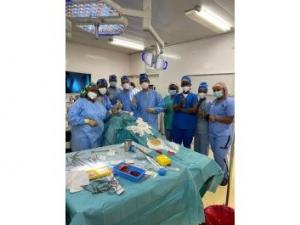VATS is a minimally invasive surgical technique used to diagnose and treat problems in the chest.
During a VATS procedure, a tiny camera (thoracoscope) and surgical instruments are inserted into your chest through one or more small incisions in your chest wall. The thoracoscope transmits images of the inside of your chest onto a video monitor, guiding the surgeon in performing the procedure.
The delegation led by Dr. Diego González Rivas, a specialist in thoracic surgery came to offer a 2-day masterclass on single incision video-assisted thoracic surgery at King Faisal Hospital.
Rwanda has one specialist in thoracic surgery at King Faisal Hospital. The training is expected to increase the number of doctors with such expertize in Rwanda.
Dr. González hailing from Japan came to Rwanda along with other specialists from China, Morocco, Spain and Russia.
They are set to spend two days at the hospital and chart ways for future cooperation.
Speaking to the media, Dr. González explained that he started applying the minimally invasive thoracic surgery in 2010 in Japan and has since then toured different countries to train other medical doctors.
He highlighted that Video-assisted thoracoscopic surgery is different from the traditional technique which is painful and takes long for recovery.
“The difference between thoracotomy [classic one] and single incision video-assisted thoracic surgery is that we have to do a big incision, spread the ribs make at least 12 cm incision, and create a big hole on the chest to operate with direct view. This is very painful for the patient because he/she has to stay at the hospital around ten days,” he said.
“With this technique, we use small incision like two centimeter incision and we can do the same with thoracoscopic instruments and the endoscopic camera and operate the patient watching the screen. We don’t need to put hands inside the chest. That is the patient has less pain, better recovery and can go home in two days with little pain. The difference is very huge,” added Dr. González.
Dr. González revealed that he developed this technique since 2010 and has been traveling around the world to train medical doctors.
“I have operated in around 120 countries so far. Most of visited countries started developing this technique. Of these, more than 20 countries are African countries. The technique is nowadays being performed all over the world that some countries use it as the main approach,” he underscored.
Dr. González further stated that the training is the beginning for future collaboration.
“I came here because I wanted to teach doctors how to do it better. The team is interested and we shall continue to keep in touch. They may come to our training center or come back to assist them,” he noted.
The CEO of King Faisal Hospital, Prof. Miliard Derbew has explained that discussions with the delegation led by Dr. González so that similar trainings can be offered locally
The mechanism to facilitate such trainings is to be put in place so that Rwandan doctors can be acquainted with necessary skills in nine months.


